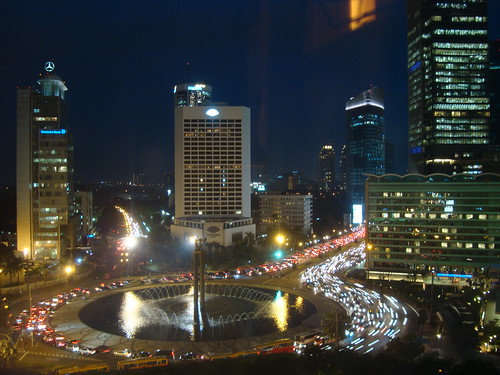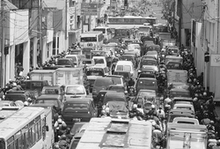Concerted steps to disentangle Jakarta traffic congestions
Many policies have been offered by the central government and the Jakarta city administration to disentangle the Jakarta chronic traffic congestions. Vice President Boediono, after the meeting with several ministers and the Jakarta Governor Fauzi Bowo on September 2, 2010, offered 17 policies to alleviate the Jakarta worsening congestion. Those policies include (1) the application of electronic road pricing (ERP), (2) the sterilization of Transjakarta lanes, (3) the improvement of on-street parking management, (4) multiyear contract for road maintenance, (5)the addition of two more Transjakarta routes by the end of 2010, (6) subsidies for natural gas usage by public transportation modes, (7) incentives for converting old minivans into new buses, (8) reactivation of commuter train routes in Jabodetabek, (9) punishment for illegal public transportations, (10)MRT, monorail and railroad access to the airport should be prioritized, (11) the creation of Transportation Authority of Jabodetabek, (12) the revision of the Integrated Transportation Master Plan of Jabodetabek, (13) the hastening of double tract project in Jakarta’s suburb areas, (14) development of the Jakarta inner-ring railroad, (15) the development of six new inner city toll road, (16) limitation of vehicles on the road, and (17) the provision of parking lots around Transjakarta stations and commuter train stations (The website of the Indonesian Vice President Office, September 2010). At the meeting, Vice President Boediono appointed the head of the Presidential Work Unit for Development Monitoring and Control (UKP4), Kuntoro Mangkusubroto, to head the team addressing the Jakarta’s transportation problems (The Jakarta Post, September 3, 2010).
The development and expansion of mass transportations including MRT, monorail, Transjakarta, train to the airport and commuter trains in inner-city and suburbs of Jakarta, as recommended by Vice President Boediono, are the fundamental key to disentangle traffic congestions in Jakarta. Such developments should be prioritized and expedited. The traffic congestion management including the application of ERP, the traffic law enforcement and the deployment of task forces to traffic congestion hot spots will also support the effectiveness of mass transportation in alleviating the transportation problems in Jakarta.
The Jakarta Transportation Agency has planned to apply the ERP in major thoroughfares which currently use the three-in-one system (The Jakarta Post, September 23, 2010). The ERP is used to impose automatically a demand sensitive congestion toll when the congestion level in the restricted zone exceeds a preferred threshold level. Only drivers with the high value of their trips will pay the charge. As a result efficient use of the road and redistribution of trips spatially, temporarily and modally will occur (Albalate and Bel 2009; Goh 2002).
Jakarta needs to learn from the success of Singapore that has implemented the ERP since April 1998. The ERP in Singapore is the upgrade system of the previous congestion measure, Area Licensing Scheme (ALS) that was introduced in 1975. The implementation of ALS reduced the traffic by 45 percent during the morning peak and another 15 percent after the introduction of the ERP. One of the contributing factors to the success of the ERP implementation is the strong commitment of the Singaporean authorities to develop and expand public mass transportation alternatives (Albalate and Bel 2009). Other cities including London and Stockholm that have successfully implemented traffic congestion charging measures also have reliable, accessible and affordable public transportation alternatives.
Among the policies proposed by Vice President Boediono and the Jakarta city administration, I found two policies that could be counterproductive to the development and expansion of mass transportation system: the development of six new inner-city toll roads and the staggering office hours. Both policies could ease the traffic congestions in the short run, but could cause more traffic congestions in the long run. The policies will not encourage drivers to convert from their vehicles to mass transportation as their primary transportation modes. They will only undermine the efforts of developing the mass transportation system in Jakarta.
Alternatively, many possible policies could be implemented in Jakarta in order to alleviate the traffic congestion including shuttle services, carpool matching services, telecommuting and downzoning. Instead of staggering office hours, the Jakarta city administration should encourage private and public companies to expand their shuttle services and develop carpool matching services for their employees.
Telecommuting is a way to reduce commuting by using telecommunications technologies. Employees can work outside the traditional office at remote work locations including their homes. A study in the US shows that telecommuting can reduce commuting for about 10.4 percent of the labor force (Cullingworth and Caves 2009). Downzoning is a measure to reduce allowable development on land zoned for service, retail or commercial development. Such a measure is mostly directed to areas along busy streets to reduce traffic congestions.
In order to support the development and expansion of mass transportation system, Jakarta also needs to develop more multimodal transportation districts. Such districts provide a mix of land uses, an interconnected network of streets designed to encourage walking and bicycling, and appropriate densities and intensities of land uses within walking distance of transit stops (Cullingworth and Caves 2009).
Jakarta is estimated to lose $3 billion a year because of traffic congestions. Concerted steps are needed to reduce the Jakarta’s traffic woes. These steps must be implemented with a strong commitment to develop and expand an integrated, reliable, accessible and affordable mass transportation system in Jakarta.
(This article also appeared at The Jakarta Post on November 13, 2010)
References:
- Albalate, Daniel and Bel, Gelma. (2009). What local policy makers should know about urban road charging: Lessons from worldwide experience. Public Administration Review 69(5): 962-975.
- Cullingworth, Barry and Caves, Roger W. (2009). Planning in the USA: Policies, Issues and Processes. London and New York: Routledge.
- Goh, Mark. (2002). Congestion management and electronic road pricing in Singapore. Journal of Transport Geography 10: 29-38.






No comments:
Post a Comment